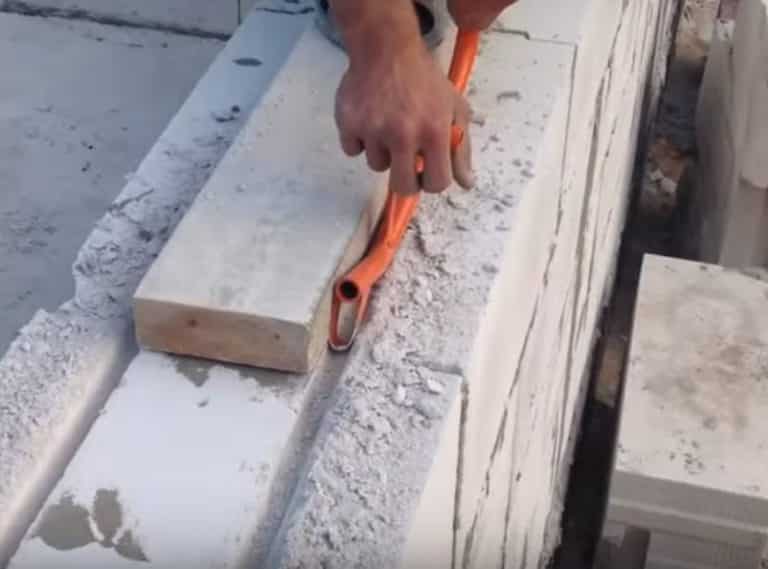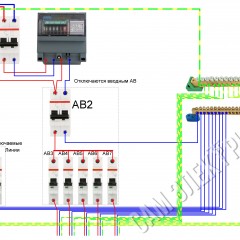What to do first: electrician or wall plaster
When building a house, everything is decided at once. If we talk about wiring, then in addition to the panel diagram and the wiring plan, you need to decide when the electrician should be carried out: before plaster or after. For those who cannot decide what to do first, we suggest reading this article.
General information
Since the question is when an electrician is made before plastering, or vice versa - after, then you definitely decided to make hidden electrical wiring. We already described the features of this process in the corresponding article: https://our.electricianexp.com/en/kak-sdelat-skrytuyu-elektroprovodku.html. So, if you have bare walls, only built, or old, but all the coverings to bricks have been removed from them, then there are two main technologies for wiring:
- Before plastering in the walls or along them, followed by facing and finishing work.
- After plastering with smoothing of smooth walls with a rough finish and subsequent seal.
Consider each of the options in more detail.
Advantages and disadvantages of electricians before finishing work
If the house is new, and this is the first installation of electricians, then this option is cheaper and more correct. When laying wiring before plastering, you need to consider:
- plaster layer thickness;
- material and wall thickness;
- the method of mounting the socket and cable, as well as their fastening.
Let's look at the main issues and problems that need to be considered in electrics before plastering.
From the thickness of the finishing layer depends on whether gating is necessary. Suppose you will lay a cable in a corrugation with a diameter of 16 mm - this is its outer diameter. Plastering with a thick layer the already even new walls is for the most part pointless and expensive. Therefore, if the thickness of the future layer is less than 1-2 cm - definitely need ditch grooves under wiring.
If the house is old and the walls are very curved, then in order to level them, you may need a layer of a few centimeters.
The thickness of the sand-cement plaster layer can be from 1.5 cm to 7 cm. A layer of 2 cm, in principle, will be enough to cover all cable lines. At the same time, you will save on strobing and grooving during further finishing.
Strobing in this case is often more difficult than using smooth gypsum or cement plaster. The price depends on the materials, for example, brick or cinder block - solid, while aerated concrete partitions are literally scratched with a screwdriver.
When installing podrozetniki, it is important not to make a mistake by placing them flush with the rough wall, because after plastering they will be too recessed deep. Therefore, wires are laid along unplastered walls, wells are made for socket boxes, they are installed, but they are not fixed, but they are done after the walls have been leveled.
Keep in mind the fact that plasterers-painters can damage the cable with spatulas and rules during operation.In addition, the laid lines partly make it difficult to install beacons along which the walls are aligned. Therefore, check the wiring and make a reservation with the plasterers if it is damaged during the work.
How to fix the cable line when laying it in front of the plaster? To do this, you can use any method you are used to, both when installing in the corrugation, and without it:
- alabaster and other gypsum mixtures;
- plastic dowels; clamps and clips;
- metal clamps.
To summarize. The main advantages in laying electrics to plaster:
- You do not do the same job twice. This means that when building with the help of wage laborers and performing work by different teams, you will not have to repeatedly call the plasterers to fill up the strob or arrange it with electricians. With each subsequent step, the cost of work increases significantly.
- You save on embedment strob.
- It turns out less garbage.
- After completing the installation work, you will not need electricians in the flesh until the end of the finishing work and the installation of all the lamps, switches and sockets.
The only drawback is the possibility of damage to the lines during wall decoration.
Pros and cons of installation after plastering
Laying electrics after plastering is often found in practice when repairing an old housing stock.
The advantage of this option is that you already see the plane of the wall and make gates and wells of the depth that is needed for the installation of wires and wiring accessories, which somewhat reduces the likelihood of errors. To hide the wires after their installation, the gates are sealed with a sand-cement mortar, then all this is sewn up with facing materials such as drywall, lining and others, or it is putty, primed and glued with wallpaper.
But this technology has a number of disadvantages:
- If the walls are thin, for example, the interior partitions are laid out on the brick floor, when the holes for the socket are chipped, plaster on the other side of the wall (in the next room) may crumble or crack.
- When ditching grooves for an electrician using a slotted cutter without a vacuum cleaner, there will be a lot of dust, and if you do this with a puncher - a little less, but the plastered surface will be damaged and a wide funnel will appear around the groove for the cable
After the work with the electrician is finished, you need to close up the strobes, and this is the repeated call of the painters and the purchase of building mixtures and again the garbage.
The disadvantages of this method are more:
- We have to do the same finishing work several times.
- Based on the previous one, everything is more expensive.
- There is a risk of damage to the plaster (cracks, etc.).
- The reinforcing mesh during the gating will be cut into pieces and there will be no sense from it.
- Garbage at each stage, as well as time and financial costs, for its cleaning and removal.
There are two obvious advantages:
- You see the final dimensions of the room and you can make the wiring of electricians more convenient.
- Installation of socket boxes and boxes is carried out once and accurately.
How to make cheaper and more correct
In recent years, the installation of electrical wiring is performed in a combined way, what is the first thing to do in this case?
In an apartment or house with bare walls, cables are laid on the ceiling or on the subfloor, if in the future it will be filled with a screed. Ceilings in most cases in 2019 do stretch or plasterboard.
The strobes are made to raise the cable from the floor or lower the cable from the ceiling to an outlet, switch or lamp. Cable lines are mounted in corrugation on clips or clamps. As a result, we can make an unambiguous conclusion:
Plumbing, electrics, the Internet and other networks, all other utilities and structures are made to plaster. After installing all of the above, they are engaged in finishing work.
Finally, we recommend that you look at the useful form on the topic where this issue is clearly considered:
We hope you understand when an electrician is being made: before or after plastering. We, in turn, described the pros and cons of each option for work and said which option is more correct.
Related materials:














